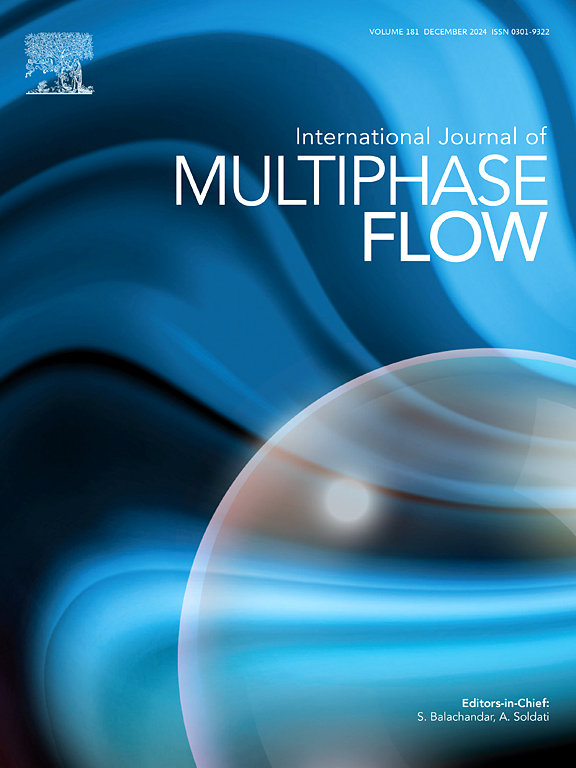水平气液两相流流致声特性的实验研究
IF 3.8
2区 工程技术
Q1 MECHANICS
International Journal of Multiphase Flow
Pub Date : 2025-07-23
DOI:10.1016/j.ijmultiphaseflow.2025.105378
引用次数: 0
摘要
在充满气泡的液体流动中,气泡的动力学行为及其与流体壁的相互作用不可避免地产生向外传播的声波,这对监测管道稳定性至关重要。然而,流型对气液两相流声(GTFIS)发射的影响,特别是在高雷诺数下,仍然没有得到充分的了解。在本研究中,利用精密水听器捕获了水平管内高雷诺数下的GTFIS信号。结果表明,GTFIS信号的能量主要集中在0 ~ 50 Hz范围内。在常规水平管道的流态中,段塞流(SG)的GTFIS信号强度最高。由于气泡诱导湍流效应和段塞流频率的共同作用,SG内的信号强度随气速线性增加。在间歇流中,GTFIS信号的非高斯性增强,近似服从稳定分布。GTFIS信号的结构复杂性和多重分形性受气泡行为和流型转变的影响。在间歇流动中,由于内部流动的间断性增强和两相分布的不均匀性,多重分形强度最大化。GTFIS的多重分形谱参数成为流型分类的有效工具。本文章由计算机程序翻译,如有差异,请以英文原文为准。

Experimental investigation on characteristics of flow-induced acoustics in horizontal gas–liquid two-phase flow
The dynamic behavior of bubbles and their interactions with fluid walls in bubble-laden liquid flows inevitably generate outwardly propagating sound waves, which are crucial for monitoring pipeline stability. However, the influence of flow patterns on gas–liquid two-phase flow-induced sound (GTFIS) emissions, especially under high Reynolds numbers, remains inadequately understood. In this study, GTFIS signals under high Reynolds numbers in a horizontal pipe were captured using a precision hydrophone. The results reveal that the energy of GTFIS signals is predominantly concentrated within 0–50 Hz. Among all flow patterns in conventional horizontal pipes, slug flow (SG) exhibits the highest GTFIS signal intensity. The signal intensity in SG increases linearly with gas velocity due to the combined effects of rising bubble-induced turbulence effect and slug frequency. In intermittent flow, the GTFIS signal exhibits increased non-Gaussianity and approximately follows a stable distribution. The structural complexity and multifractality of GTFIS signals are governed by bubble behavior and flow pattern transitions. Furthermore, in intermittent flow, the multifractal strength is maximized due to the enhanced intermittency of the internal flow and the inhomogeneous two-phase distribution. The parameters of the multifractal spectrum for GTFIS emerge as effective tools for flow pattern classification.
求助全文
通过发布文献求助,成功后即可免费获取论文全文。
去求助
来源期刊
CiteScore
7.30
自引率
10.50%
发文量
244
审稿时长
4 months
期刊介绍:
The International Journal of Multiphase Flow publishes analytical, numerical and experimental articles of lasting interest. The scope of the journal includes all aspects of mass, momentum and energy exchange phenomena among different phases such as occur in disperse flows, gas–liquid and liquid–liquid flows, flows in porous media, boiling, granular flows and others.
The journal publishes full papers, brief communications and conference announcements.

 求助内容:
求助内容: 应助结果提醒方式:
应助结果提醒方式:


